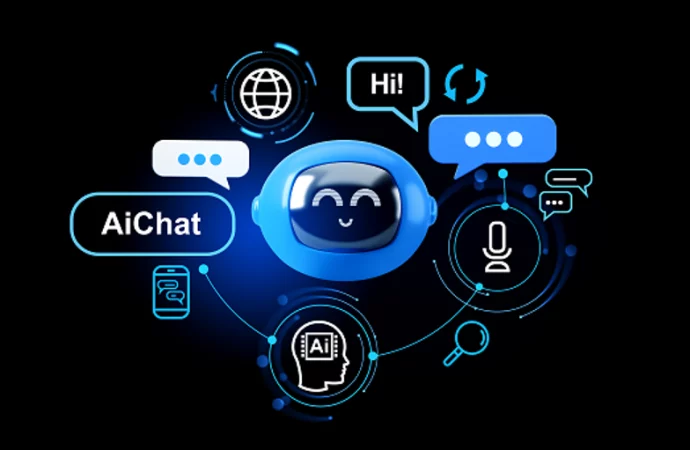Introduction In today’s fast-paced digital world, businesses are constantly seeking innovative ways to enhance customer experience and reduce operational costs. One of the most groundbreaking technologies that has transformed the customer service landscape is the AI chatbot. From small startups to global enterprises, companies are increasingly adopting AI-powered chatbots to deliver instant, accurate, and human-like
Introduction
In today’s fast-paced digital world, businesses are constantly seeking innovative ways to enhance customer experience and reduce operational costs. One of the most groundbreaking technologies that has transformed the customer service landscape is the AI chatbot. From small startups to global enterprises, companies are increasingly adopting AI-powered chatbots to deliver instant, accurate, and human-like support.
What Is an AI Chatbot?
An AI chatbot is a software application that uses artificial intelligence, natural language processing (NLP), and machine learning to simulate human-like conversations with users. These bots can understand user queries, process language contextually, and respond appropriately—without human intervention.
AI chatbots are not limited to simple question-and-answer interactions. Today’s intelligent bots can manage complex workflows, respond with empathy, and even initiate meaningful conversations that drive engagement and conversions.
The Rise of 24/7 Support
One of the biggest ways AI chatbots have improved customer service is by offering support all day, every day. Unlike human agents who need breaks or work in shifts, chatbots don’t sleep. That means customers can get help at any time—whether it’s early morning, late at night, or even on a holiday.
This kind of 24/7 support makes customers feel cared for. No one likes waiting for hours to get help. With AI chatbots, help is always just a message away.
Faster Response Times
Speed matters in customer service. Nobody wants to wait in a long queue to talk to a support agent. AI chatbots fix this problem by giving instant replies. They can handle thousands of chats at the same time without slowing down.
In 2025, the average response time with a chatbot is just a few seconds. That’s a big win for customers and businesses alike. Quick replies lead to happier customers, and happy customers are more likely to come back.
Personalization at Scale
Today’s AI chatbots don’t just give the same answer to everyone. They use customer data to personalize responses. This means the chatbot might greet you by name, know your order history, and even suggest solutions based on your past behavior.
This level of personalization helps build trust. It shows that the company understands your needs and is ready to help in the best possible way. And since it’s all done by AI, companies can offer this special treatment to millions of people at once.
Handling More Than Just Simple Questions
In the past, chatbots were only good for answering easy questions like “What are your hours?” or “How can I reset my password?” But in 2025, they can do so much more.
Modern AI chatbots can:
- Help you complete purchases
- Walk you through tech problems
- Process refunds and returns
- Book appointments
- Track shipments
They are also smart enough to know when they need help. If a chatbot can’t solve a problem, it can quickly hand the issue over to a human agent. This keeps the customer from getting frustrated and makes sure they get the help they need.
Cost Savings for Businesses
Using AI chatbots can save companies a lot of money. Hiring and training customer service teams can be expensive. Chatbots help by handling a large number of customer requests on their own. This means businesses can reduce the size of their support teams or let their human agents focus on harder tasks.
By 2025, many companies have seen big savings thanks to AI-powered support. And they’re still giving great service—even better than before in many cases.
Supporting Multiple Languages
In today’s global world, companies serve people who speak many different languages. AI chatbots in 2025 can speak and understand dozens of languages. This means companies can talk to customers around the world without needing a big team of translators.
This makes customer support faster, easier, and more welcoming to everyone—no matter where they’re from or what language they speak.
Benefits of Using AI Chatbots for Customer Service
- 24/7 Availability: Unlike human agents, chatbots don’t need breaks. They can provide round-the-clock assistance, ensuring that customers from different time zones receive instant help whenever they need it.
- Instant Response Time: AI chatbots can respond to multiple customer queries simultaneously, eliminating wait times. This leads to increased customer satisfaction and lower bounce rates on websites.
- Cost-Effective Support: Hiring and training a full customer support team can be expensive. Chatbots reduce the need for large teams by automating routine queries, allowing human agents to focus on more complex issues.
- Multilingual Support: Advanced chatbots can handle conversations in multiple languages, helping businesses reach a wider audience and maintain global presence effortlessly.
- Personalized User Experience: Chatbots can access customer data to deliver personalized responses. For example, they can greet a returning user by name, recommend products based on purchase history, or provide updates on pending orders.
Use Cases of AI Chatbots in Different Industries
- Retail & E-commerce: Assisting customers with product selection, order tracking, and returns.
- Banking & Finance: Helping users check balances, report fraud, and apply for loans.
- Travel & Hospitality: Booking tickets, managing itineraries, and answering FAQs.
Challenges in Implementing Chatbots
- Despite their many advantages, chatbot implementation does come with some challenges:
- Poorly trained bots may frustrate users with irrelevant answers.
- Complex queries may still require escalation to human agents.
- Data security and privacy concerns are significant, especially in sectors like finance and healthcare.
To address these issues, it’s essential to choose a reliable AI platform and continuously train the bot using customer feedback and updated datasets.
Integration with CRM and Business Tools

Image by: Yandex.com
Modern AI chatbots are not standalone systems they are increasingly being integrated with Customer Relationship Management (CRM) tools, email marketing platforms, and analytics dashboards. This enables businesses to gain a holistic view of customer interactions and behavior. For example, when a chatbot logs a support query, it can automatically create a case in the CRM, assign it to a human agent if needed, and follow up via email or SMS. These integrations make customer service workflows more efficient and data-driven, ensuring nothing falls through the cracks.
Continuous Learning and Improvement
AI chatbots are designed to learn and evolve over time. With each interaction, they gather data that helps them improve future responses. This continuous learning is powered by machine learning algorithms and user feedback loops. Businesses can use analytics to identify gaps in chatbot understanding and train the model to handle new types of queries. As a result, the chatbot becomes smarter, more accurate, and more aligned with user expectations delivering a superior customer experience month after month.
Real-World Examples of AI Chatbot Success
Leading brands around the globe are already showcasing the power of AI chatbots in action. For instance, Sephora uses chatbots to offer beauty consultations, product recommendations, and even schedule in-store makeovers. Similarly, Bank of America’s virtual assistant “Erica” helps customers manage finances, track spending, and get bill reminders through natural language queries. These real-world applications not only streamline operations but also build stronger customer loyalty by providing smart, intuitive, and helpful digital assistants.
Small businesses too are benefiting from affordable chatbot integrations. Platforms like Facebook Messenger, WhatsApp Business, and even website builders like Wix and Shopify offer plug-and-play chatbot tools. These help startups engage with customers, handle inquiries, and even close sales all without needing a full-fledged support team. With such accessible tools now available, businesses of any size can deploy a powerful AI chatbot strategy.
Enhancing Customer Engagement Through Omnichannel Chatbots
AI chatbots are now evolving into omnichannel support systems, capable of operating across websites, mobile apps, social media platforms, and messaging apps like WhatsApp, Facebook Messenger, and Instagram. This means customers can start a conversation on one channel and seamlessly continue it on another without losing context. Such consistency not only boosts engagement but also strengthens brand trust. By meeting customers where they already are, businesses create a more connected and satisfying support experience, reducing friction and improving loyalty.
The Future of AI Chatbots
With rapid advancements in generative AI and natural language understanding, the future of chatbots looks incredibly promising. We are already seeing bots capable of holding contextual conversations, detecting emotions, and even generating visual content.
By 2030, it is expected that over 80% of all customer interactions will be handled by automated systems. Businesses that embrace this technology now are likely to gain a significant competitive advantage.
Want to Learn More?
If you’re interested in exploring how AI-powered solutions can benefit your business, check out this AI chatbot service for a hands-on experience. They offer tools to build intelligent bots tailored to your industry and customer needs.
















